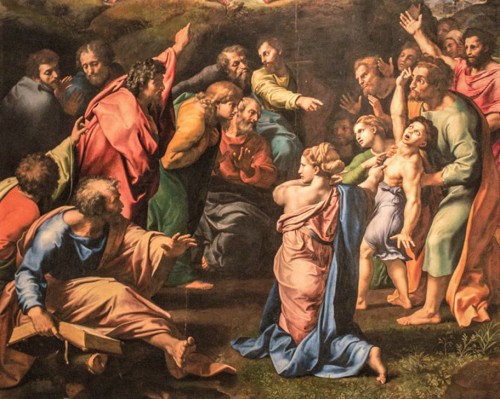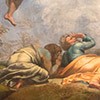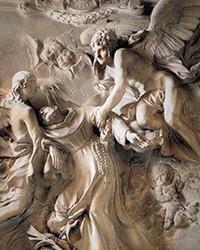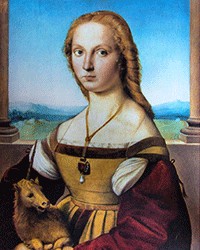
The Transfiguration, fragment,Raphael, Pinacoteca Vaticana (Musei Vaticani)

The Transfiguration,Raphael, Pinacoteca Vaticana (Musei Vaticani)

The Transfiguration,fragment,Raphael, Pinacoteca Vaticana (Musei Vaticani)

The Transfiguration,fragment,Raphael,Pinacoteca Vaticana (Musei Vaticani)

The Transfiguration,fragment,Raphael,Pinacoteca Vaticana (Musei Vaticani)

The Transfiguration,fragment,Raphael,Pinacoteca Vaticana (Musei Vaticani)

The Transfiguration,fragment,Raphael,Pinacoteca Vaticana (Musei Vaticani)

The Transfiguration,Raphael,Pinacoteca Vaticana (Musei Vaticani)

The Transfiguration,fragment,Raphael,Pinacoteca Vaticana (Musei Vaticani)
He was viewed as a painting genius, while his painting as exceptional. His figures were beautiful, both in the physical as well as the spiritual dimension, compositions were clear, the color scheme perfect. However, Raphael's last work cannot be characterized in this way. The artist has no desire to emanate with harmony, just the opposite – he puts us in front of distinct emotions, faces twisted in a grimace, dramatic gestures, and shouts, which seem to come to the viewer from inside the painting.
He was viewed as a painting genius, while his painting as exceptional. His figures were beautiful, both in the physical as well as the spiritual dimension, compositions were clear, the color scheme perfect. However, Raphael's last work cannot be characterized in this way. The artist has no desire to emanate with harmony, just the opposite – he puts us in front of distinct emotions, faces twisted in a grimace, dramatic gestures, and shouts, which seem to come to the viewer from inside the painting.
Raphael’s stay in Rome was marked with incredible success. Popes loved him, the intellectual elites held him in great esteem, while each of his works aroused admiration. He worked at a feverish pace, while the tasks, bestowed upon him by his last patron, Pope Leo X were enormous and concerned the protection of ancient historical sites, architectural designs, and the painting decorations of the papal apartments (Raphael’s Stanzas). At a certain point, the last of these tasks was entrusted by the artist to a group of trusted, outstanding painters, his collaborators, and students. In this way, he created a sort of artistic commune, which rather quickly filled the walls with frescoes, designated for the pope and other influential clients. However, there were also moments when Raphael took up the paintbrush himself, creating masterpieces of portrait art, or great reredoses. This was the case in 1517 when Cardinal Giulio Medici visited his workshop. This relative of Pope Leo X, and at the same time future pope (Clement VII), similarly to Leo X was interested in art. He desired to commission a rather large altarpiece for the Narbonne Cathedral in France, where he was a titular cardinal. Burdened by all his commissions Raphael, who besides work also valued his private life, including – the rather rich, as Giorgio Vasari claimed – romantic one, could not refuse such a significant client.
He worked on the painting for a long time. In it, he included everything that he had learned from his masters, including the one who had influenced his art the most and who jealously guarded his workshop secretes – Michelangelo. From him, he took a certain anxiety, dramaturgy of composition, a tendency to capture his figures in a sudden movement, a surprising equilibristic twist of muscled bodies, and most of all that, which is generally referred to as grande maniera.
What does Raphael’s painting actually represent? This is one of the key episodes of the Salvation History represented in the Gospel – the miraculous meeting of Jesus with the prophets Moses (with tablets) and Elijah (with a book) on Mount Tabor, who is accompanied by three apostles: Peter, John, and James. A few days before the crucifixion, they were asked by their Rabbi to accompany him to the mountain. What happened there was incomprehensible for the disciples and aroused their fear. Here, Christ showed himself to them in a glowing cloud in the company of two prophets. We see them as they are blinded by the light coming from Him, and fall to the ground. This upper part of the painting – divine and supernatural – is characterized by the typical for Raphael classical beauty, further underlined by the landscape stretching in the background. Only a gust of wind introduces slight anxiety into this scene.
The lower part is the epitome of confusion. Our attention is focused on a boy possessed by some evil power (epilepsy), whom numerous figures are pointing at with their fingers. On the left these are the disciples, on the right an unnamed crowd, most likely the family of the epileptic – who is visibly asking them for help. He is supported by an old man with bulging eyes, terrified and mute. A woman with her back to the onlooker, who is interpreted as the personification of Faith, points to him with both hands, directing her gaze towards the apostles. She clearly orders them to act, but they seem to be disoriented and only two of them point to the scene taking place above their heads and towards Jesus as if to say that this is where you should seek help. According to the Gospel, returning from Mount Tabor, Christ cured a boy and cast out a demon. We see him on the left in two separate figures –praying and giving himself over to God. Placing this small detail in the composition is very important and highlights the ideological message of the commissioned work. It was the wish of the cardinal, and later Pope Clement VII, to accentuate prayer and mortification (fasting) as the most important Christian deeds. Despite what Luther claimed (salvation can be experienced only through faith), with whom the Roman Catholic Church argued at that time, the pope underlined the significance of deeds necessary for salvation. Faith, as the disoriented apostles show us, is not enough. As we can read in the Gospel (Mt. 17, 14-21), “Then came the disciples to Jesus apart, and said, Why could not we cast him out?

And Jesus said unto them, Because of your unbelief: for verily I say unto you, If ye have faith as a grain of mustard seed, ye shall say unto this mountain, Remove hence to yonder place; and it shall remove; and nothing shall be impossible unto you. Howbeit this kind goeth not out but by prayer and fasting”. This is one of the interpretations, another claims that the youths depicted on the painting are the patron saints of the Narbonne Cathedral – Justus and Pastor, whom the Catholic calendar commemorates on August 6th, meaning the Feast of the Transfiguration.
At the time of Raphael’s death, in April 1520, the painting was not finished. The master focused on its upper part, the lower one was finished, similarly to other unfinished works of the painter, by his friend and trusted collaborator of great talent – Giulio Romano. He was aided in this task by another student Gianfrancesco Penni. The client received The Transfiguration two years after the death of its creator. Giorgio Vasari, a contemporary of Raphael and the author of The Lives of the Most Excellent Painters…called it “the most beautiful and the most divine of all Raphael’s works”, while in describing the scene of the laying out of the body of the painter prior to the funeral ceremony, with this very painting at his headrest he finished off with: “and just looking at the dead body and the living painting, made everybody’s soul cry with pain”.
Clement VII liked the painting so much that he did not turn it over to the Narbonne Cathedral. Instead, he sent a painting by Sebastiano del Piombo (Raising of Lazarus), while Raphael’s work was destined for the Church of San Pietro in Montorio. It hung in the main altar until Napoleon's armies entered Rome. The French seized it and it did not return to Rome until the fall of Bonaparte in 1816, thanks to the endeavors of the indispensable in the struggle for the recovery of great works, sculptor – Antonio Canova. However, it did not come back to the church on the Trastevere, but rather it found its place in one of the rooms of the Pinacoteca Vaticana, where it can still be viewed today.
The Transfiguration, Raphael, 1517–1520, tempera on wood, 410 cm x 279 cm, Musei Vaticani – Pinacoteca Vaticana
If you liked this article, you can help us continue to work by supporting the roma-nonpertutti portal concrete — by sharing newsletters and donating even small amounts. They will help us in our further work.
You can make one-time deposits to your account:
Barbara Kokoska
BIGBPLPW 62 1160 2202 0000 0002 3744 2108
or support on a regular basis with Patonite.pl (lower left corner)
Know that we appreciate it very much and thank You !



























